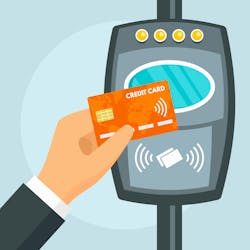Guest Column: Urban mobility’s hands-free future is near
What if you could travel through a city anywhere in the world without the need to fumble for your wallet or even your phone? This vision of “hands-free” transit is part of the future – and it’s closer than we may realize.
Digital payments on transit, like open-loop contactless ‘tap-to-ride’ technology, is an early step toward this new era of urban mobility. We’re finding that it’s no longer a question of whether transit systems will adopt these types of payments – it’s now a question of when they’ll do it and how they’ll implement. So, what’s the next step? Here’s where we see urban mobility heading in the short and long term.
Where the future meets hands free
The increasingly global adoption of contactless payments signals a widespread shift towards the hassle-free travel experience. Already, open-loop technology, which is a form of account-based ticketing (ABT), enables a faster, easier and more secure way to pay for fares and it’s available in more than 750 transit systems worldwide.
With ABT infrastructure, cities are laying the groundwork for more intuitive experiences. ABT differs from traditional card-based ticketing (CBT) in that its system is linked to an account in a central host system rather than the smart cards themselves, as you’d see with CBT.
Whether through biometrics, Bluetooth, geofences or ultrasonic data, a range of technologies will further transform the way we access urban travel, building on the potential of ABT. Transit agencies are already exploring Be In / Be Out (BIBO) systems that are not just hassle-free, but also hands free.
Transportation’s MaaSive potential
Yet, public transit can still be a fragmented experience in many cities, with the majority of public transit riders noting they use four or more payment methods per month. Globally, fewer than one in five riders use a single payment method.
The solution to this problem could be solved with Mobility as a Service (MaaS). As cities focus on reducing friction on their transit systems, boosting resilience and catering to the preferences of the traveling public, MaaS can help bring the experience (payments included) into one centralized app. Also underpinned by ABT architecture, MaaS connects riders to a wider array of choices to plan, book and pay for multimodal travel.
Partnership and the road ahead
Open-loop systems can help public transit agencies as they strive to broaden accessibility for all, regardless of income or access to formal financial services and it’s underpinned by the same ABT architecture that will enable the bright futures of MaaS and other technologies that can facilitate a hands-free travel experience.
With contactless, open-loop systems, transit agencies can allocate banking and clearinghouse tasks to financial service firms – creating more opportunities for collaboration between both industries. These partnerships can help agencies simplify fare payment processes, reduce cash management and fare collection overheads and mitigate financial risks such as fraud and fare evasion. That will be important as transit agencies work to free up resources to optimize route plans, enhance operational efficiency and invest in more sustainable transportation.
We’re on the road to a frictionless, door-to-door urban mobility experience as new technology paves the way to advance the rider experience. So, grab your ‘virtual’ ticket and come ride with us towards a hands-free travel future.
About the Author

Nick Mackie
Nick Mackie is vice president, mobility solutions at Visa.
Based in London, he and his team are responsible for liberating the full potential of Visa’s network and partners to transform the way we move inside and between urban centers.
His aim is to improve end-to-end journey experiences for the travelling public, deliver greater efficiency for operators and governments and boost the economic output of our cities.
Prior to his current role, Mackie served five years as head of contactless, leading the establishment of contactless payments in Europe, which today account for more than 90 percent of Visa’s face-to-face payments. During this time, Mackie played a key role in supporting Transport for London’s groundbreaking contactless rollout in September 2014.
Before joining Visa, Nick was head of business development at Vianet Group plc, a UK-based technology and IoT provider for the leisure and petrol forecourt sectors.
Mackie holds a first-class B.Eng. Honours degree in Electronic and Communications Engineering (Class Medal winner) and an M.Phil. in Applied Telecommunications.
